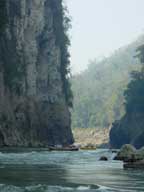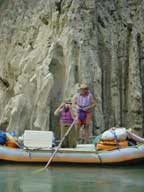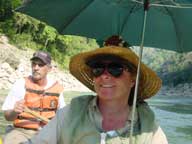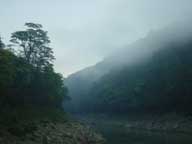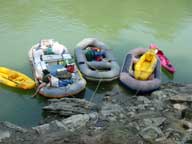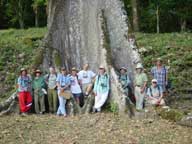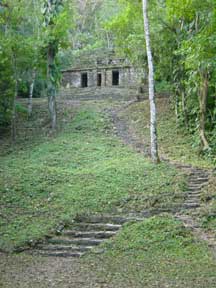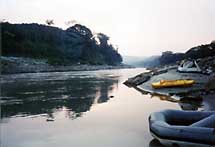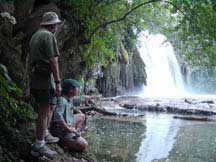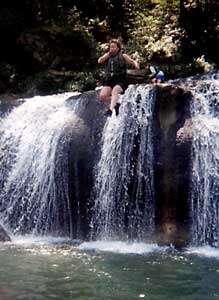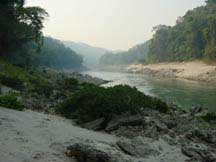THE USUMACINTA RIVER EXPEDITION
DUE TO BANDIT ACTIVITY IN THE AREA WE HAVE NOT DONE THIS WONDERFUL TRIP FOR SEVERAL YEARS.
PLEASE CONTACT ME FOR MORE INFO.
PLEASE CONTACT ME FOR MORE INFO.
Notes: These are friends trips. We have no Insurance and you will need to sign a waiver. It is best to arrive in Palenque two days before put-in date. We pay for the hotel the day before put-in, then nine days on the river. We have the option of staying in either Tenosique or Palenque the night after take-out.
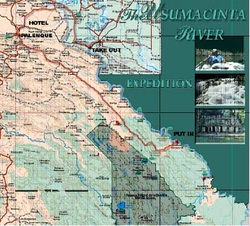 Graphic by Don Patterson
Graphic by Don Patterson
Dear Friends,
All of us appreciate the personal effort that you have contributed in order to make this expedition possible and we are excitedly looking forward to your company.
Un abrazo and let the journey begin…
GENERAL INFORMATION
The Usumacinta River and its archaeological sites are a phenomenon every river runner, archaeology buff and conservationist should experience. However, gaining access to this remote area imposes a few special conditions on our trips.
It will be a long first day. We leave Palenque very early to arrive in Frontera Corizal and rig the boat mid-day. Then we float 2 hours to Yaxchilan for a quick visit to the ruins and dinner.
Because of the social, economic and political instability of the area this part of the expedition must be made during daylight hours. There will probably be several military roadblocks between Palenque and Frontera. So you must carry your passport and/or Mexican tourist visa with you . Once we reach the river we will need a couple of hours to blow up the rafts and accommodate the gear before heading for the three hour float down river to Yaxchilan. Barring any unforeseen difficulties we should be in Yaxchilan by four or five o’clock in the afternoon. Our expedition will be self-supported on the river for the next eight days. Because of this, expedition members should be in good physical condition. Strenuous moments can be expected. We will be traveling in one of the last Wilderness areas in Mexico. In case of injury, evacuation can be slow and tedious. It is possible on trips of this nature that unforeseen difficulties may be encountered. The river has been used recently by drug smugglers so we may be stopped and our equipment and gear searched at any time or any place along the journey.
Reasonable changes in itinerary may be made where deemed advisable for the comfort and safety of the expedition member. Everyone that joins our groups will have to accept the associated risks of such and expedition. There is no insurance and you will be required to sign a waiver before leaving Palenque. However, our group leaders are seasoned travelers and know this area of Mexico and will make every effort to ensure that the trips are a great success.
The climate is typical of these latitudes of rainforests: hot and humid. Daytime temperatures are often in the low 90 degrees F, nights sometimes as low as 50 degrees F. March is the dry season, but occasional rains occur as in any tropical environment. Generally speaking, it is usually very pleasant on the river.
THE USUMACINTA RIVER
The Usumacinta is one of the largest rivers in Mexico. Also, it is one of the few rivers in North America that flow north. The river begins at the confluence of the Chixoy and Pasion rivers on the north eastern slopes of the Highlands of Guatemala. A few kilometers North West of this confluence the river is joined by the major drainage system of the Lacandon National Forest, the Lacantun River. On a nearby beach, as if to signal this important point, some ancient figures and symbols have been carved on the rocks.
North of the Lacantun, the Usumacinta cuts through the thick limestone bed and winds its way through one of North Americas most romantic wilderness. This mid-section of the river forms the political boundary between Mexico and the Peten of Guatemala for over 140 km. Here the river is supported with a number of enchanting arroyos and streams with equally enchanting names: the Yaxchilan, Busilja, Chancala, etc. Just before the Usumacinta passes out into the savannahs and plains of Chiapas and Tabasco the river cuts a magnificent canyon through the limestone. Throughout this canyon, travertine formations, created by dissolved limestone deposits, create a fantasy of geological shapes.
During the first millennium after Christ, the Maya traveled up and down this river in their dug out canoes. The number of archaeological sites on or near both river banks bears quiet testimony of the Mayas use and exploitation of the area. The beautiful carved monuments of Yaxchilan have supplied important hieroglyphic texts for archaeologists, artists, art historians and epigraphers. Thanks to the combined efforts of these investigators many of the carved figures at these sites now have names and personalities.
At Yaxchilan you will gain an historical understanding of the ruins and learn to read a number of Calendrical and Historical Mayan Hieroglyphs. During our descent of the Usumacinta we will also explore the otherwise inaccesible Classic Mayan site of Piedras Negras in Guatemala.
Our journey begins the following morning on the, “River of the Sacred Monkey”. During a typical day we will float for four to five hours. By early afternoon we will set up camp on untracked sandy beaches in the heart of the rain forest. After a hearty dinner, enjoy a driftwood campfire under star-filled skies accompanied by the orchestration of jungle sounds.
Several stretches of the river have beautiful waterfalls cascading from the cliffs above, which are delightfully refreshing. The Usumacinta is remarkably clean for it’s size and perfect for swimming. The forest on both sides of the river is alive with an amazing assortment of tropical flora and fauna; multi-colored flowers, parrots, the ever present Howler Monkeys and the elusive jaguar.
The 124 kms of the river that we will be running has short powerful, pool-drop rapids.These vary in difficulty with the water level,but all are straight forward and easy to run. Toward the end of the trip the rafts float in the narrow river channel between the steep, 300 meter walls of the San Jose canyon mentioned above. Trees, vines and vegetation cling to the nearly vertical walls as you pass through this tropical fantasy.
For a different first-hand travelog of the trip, visit this tour .
All of us appreciate the personal effort that you have contributed in order to make this expedition possible and we are excitedly looking forward to your company.
Un abrazo and let the journey begin…
GENERAL INFORMATION
The Usumacinta River and its archaeological sites are a phenomenon every river runner, archaeology buff and conservationist should experience. However, gaining access to this remote area imposes a few special conditions on our trips.
It will be a long first day. We leave Palenque very early to arrive in Frontera Corizal and rig the boat mid-day. Then we float 2 hours to Yaxchilan for a quick visit to the ruins and dinner.
Because of the social, economic and political instability of the area this part of the expedition must be made during daylight hours. There will probably be several military roadblocks between Palenque and Frontera. So you must carry your passport and/or Mexican tourist visa with you . Once we reach the river we will need a couple of hours to blow up the rafts and accommodate the gear before heading for the three hour float down river to Yaxchilan. Barring any unforeseen difficulties we should be in Yaxchilan by four or five o’clock in the afternoon. Our expedition will be self-supported on the river for the next eight days. Because of this, expedition members should be in good physical condition. Strenuous moments can be expected. We will be traveling in one of the last Wilderness areas in Mexico. In case of injury, evacuation can be slow and tedious. It is possible on trips of this nature that unforeseen difficulties may be encountered. The river has been used recently by drug smugglers so we may be stopped and our equipment and gear searched at any time or any place along the journey.
Reasonable changes in itinerary may be made where deemed advisable for the comfort and safety of the expedition member. Everyone that joins our groups will have to accept the associated risks of such and expedition. There is no insurance and you will be required to sign a waiver before leaving Palenque. However, our group leaders are seasoned travelers and know this area of Mexico and will make every effort to ensure that the trips are a great success.
The climate is typical of these latitudes of rainforests: hot and humid. Daytime temperatures are often in the low 90 degrees F, nights sometimes as low as 50 degrees F. March is the dry season, but occasional rains occur as in any tropical environment. Generally speaking, it is usually very pleasant on the river.
THE USUMACINTA RIVER
The Usumacinta is one of the largest rivers in Mexico. Also, it is one of the few rivers in North America that flow north. The river begins at the confluence of the Chixoy and Pasion rivers on the north eastern slopes of the Highlands of Guatemala. A few kilometers North West of this confluence the river is joined by the major drainage system of the Lacandon National Forest, the Lacantun River. On a nearby beach, as if to signal this important point, some ancient figures and symbols have been carved on the rocks.
North of the Lacantun, the Usumacinta cuts through the thick limestone bed and winds its way through one of North Americas most romantic wilderness. This mid-section of the river forms the political boundary between Mexico and the Peten of Guatemala for over 140 km. Here the river is supported with a number of enchanting arroyos and streams with equally enchanting names: the Yaxchilan, Busilja, Chancala, etc. Just before the Usumacinta passes out into the savannahs and plains of Chiapas and Tabasco the river cuts a magnificent canyon through the limestone. Throughout this canyon, travertine formations, created by dissolved limestone deposits, create a fantasy of geological shapes.
During the first millennium after Christ, the Maya traveled up and down this river in their dug out canoes. The number of archaeological sites on or near both river banks bears quiet testimony of the Mayas use and exploitation of the area. The beautiful carved monuments of Yaxchilan have supplied important hieroglyphic texts for archaeologists, artists, art historians and epigraphers. Thanks to the combined efforts of these investigators many of the carved figures at these sites now have names and personalities.
At Yaxchilan you will gain an historical understanding of the ruins and learn to read a number of Calendrical and Historical Mayan Hieroglyphs. During our descent of the Usumacinta we will also explore the otherwise inaccesible Classic Mayan site of Piedras Negras in Guatemala.
Our journey begins the following morning on the, “River of the Sacred Monkey”. During a typical day we will float for four to five hours. By early afternoon we will set up camp on untracked sandy beaches in the heart of the rain forest. After a hearty dinner, enjoy a driftwood campfire under star-filled skies accompanied by the orchestration of jungle sounds.
Several stretches of the river have beautiful waterfalls cascading from the cliffs above, which are delightfully refreshing. The Usumacinta is remarkably clean for it’s size and perfect for swimming. The forest on both sides of the river is alive with an amazing assortment of tropical flora and fauna; multi-colored flowers, parrots, the ever present Howler Monkeys and the elusive jaguar.
The 124 kms of the river that we will be running has short powerful, pool-drop rapids.These vary in difficulty with the water level,but all are straight forward and easy to run. Toward the end of the trip the rafts float in the narrow river channel between the steep, 300 meter walls of the San Jose canyon mentioned above. Trees, vines and vegetation cling to the nearly vertical walls as you pass through this tropical fantasy.
For a different first-hand travelog of the trip, visit this tour .

